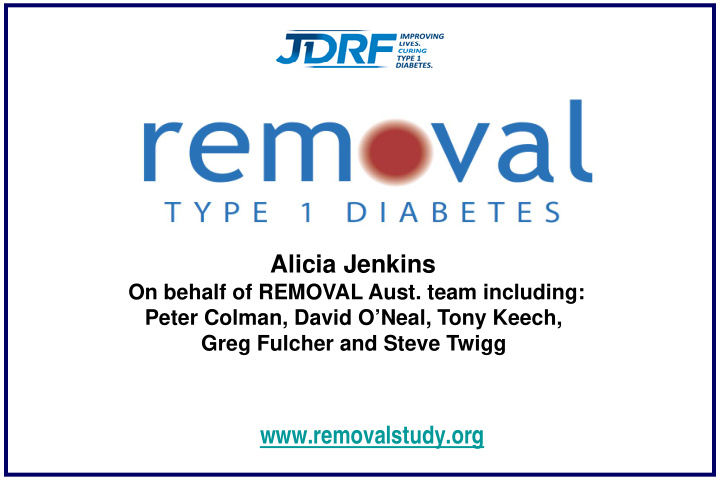



Alicia Jenkins On behalf of REMOVAL Aust. team including: Peter Colman, David O’Neal, Tony Keech, Greg Fulcher and Steve Twigg www.removalstudy.org
Double Diabetes Metformin In T1D
Use of Metformin in T1D • UK registry - 29% with T1D have had metformin script J Petrie, H Colhoun personal communication • Local use @ RPAH 15% , SVH 9.5% A Jenkins, G Tun, D O’Neal, G Ward, M McGill, A Januszewski, J Wong, S Twigg et al
Metformin in T1D in the Literature Minor benefits metabolic control • Over 192 clinical studies in people with T1D • Meta-analysis - 9 RCTs, 1 wk - 1 yr, median 4 Month • Metformin (1 – 2.5 g) vs placebo associated with: • ↓Insulin 6.6 IU/day (5.7 -10.1 IU/day in 6 of 7 studies ) • Non-significant ↓ 0.11% in HbA 1C ( 0.6 - 0.9% in 4 of 7 studies) • Weight 1.7 - 6.0 kg in 3 of 6 studies • Total cholesterol 0.3 -0.41 mmol/L in 3 of 7 studies • Trend to more hypoglycaemia Vella, Petrie Diabetologia 2010 CGM study - no change glycaemic variability •
Metformin and Vascular Health?
REversing with MetfOrmin Vascular Adverse Lesions in Type 1 Diabetes
6 Countries - 23 Sites Scotland - Steno Denmark Glasgow Dundee Edinburgh Canada England London, Ontario Newcastle Ottawa Durham Salford Manchester Netherlands Hull Maastricht Australia (CTC) Aintree A Jenkins AC Keech London RPAH Steve Twigg / Greg Fulcher Plymouth SVH David O’Neal Exeter RMH Peter Colman Chief Investigator: John Petrie (Glasgow) Deputy: Helen Colhoun (Dundee)
Study Outline • double-blind randomised, placebo-controlled trial • T1DM aged ≥40 years, HbA1c ≥ 7 - 10% and ↑ CVD risk. • 3 or more of 10 risk factors: • three years metformin 1000 mg b.d. or placebo (as tolerated) added to titrated insulin [towards HbA1c 7.0% (53 mmol/mol)] Target: n = 500 ( BMI > 27 kg/m2; current HbA1c > 8.0% (64 mmol/mol); CVD/PVD; current smoker: eGFR < 90 ml/min per 1.73 m2: micro- or macroalbuminuria; hypertension (BP ≥ 140/ 90 mmHg or on BP drugs; dyslipidaemia [TC≥ 5.0 mmol/L ; or HDL-C <1.0 mmol/L; or trigs≥ 1.7 mmol/L; or on lipid drugs); strong family history CVD; T1D > 20 yrs)
Design Males and females with T1DM , aged > 40 years, HbA1c>7.0 <10%; not on metformin, three or more CVD risk factors. Eligibility/ informed consent: metabolic, anthropometric assessments 3-month run-in: optimise insulin and CV risk factor management Carotid IMT , retinal images, metabolic/ anthropometric assessments RANDOMIZATION Metformin 500mg daily, Matching placebo , titrating to 1 g bd over 4 weeks titrating over 4 weeks with supported insulin dose with supported insulin dose titration to target HbA1c 7.0% titration to target HbA1c 7.0% 3-6 monthly dispensing, tablet checks, insulin dose and hypoglycaemia recording Three annual repeat visits for carotid IMT, metabolic/ anthropometric assessments; repeat retinal images at final visit. Study close-out after three years for each participant AUSTRALIAN SUBSTUDY Echocardiogram and WBC AMPKinase Activity (baseline, years 1 and 3)
Primary endpoint: carotid IMT Averaged mean far wall common carotid artery intima-media thickness High resolution B-mode ultrasound Bots ML. Carotid intima-media thickness measurements in intervention studies design options, progression rates, and sample size considerations. Stroke 2003; 34: 2985-2994.
Secondary endpoints: (i) HbA1c; (ii) LDL-C; (iii) albuminuria & eGFR (iv) retinopathy stage (ETDRS and retinal vessel calibre); not all sites (v) weight (vi) insulin dose; (vii) endothelial function “EndoPat” (not all sites). 2 or more specified as clinically significant 2 2 1 1 OD-Fields 1 and 2 OS-Fields 1 and 2
Tertiary endpoints (i) hypoglycaemia; (ii) treatment satisfaction; (iii) markers of endothelial function (t-PA, sE-selectin, sICAM-1, others; (iv) progression of mean maximal distal common carotid artery IMT (v) vitamin B12
Australian Sub-Studies • Participation in multi-country retinal studies (camera) • Participation in multi-country vascular function studies (EndoPat) 60 T1D and 45 age and gender matched non-diabetic subjects • Echocardiogram – incl. cardiac function and cardiac backscatter (software) • AMPKinase activity – WBC prep.
Progress Started 2012 Recruitment end July 2014 About 500 subjects T1D recruited and about 450 randomised Close out 2017 Australian Substudy (Echos and AMPK) 60 Australians with T1D No major safety signals
Advantages of JDRF CRN Support 2 2 1 1 OD-Fields 1 and 2 OS-Fields 1 and 2 Increased international profile (other studies, other grants) Increased local profile with T1D community Reduced funding gap
What can we improve on? • Greater closure of the funding gap • Outreach to adult T1D community • Contracts 16
Acknowledgements REMOVAL Aust. Investigators Melbourne Sydney SVH RPAH • David O’Neal and team including • Steve Twigg and team, including • Alicia Jenkins • Connie Luo / Rebecca Denner • Bala Krishnamurthy • Belinda Brookes • Jodie Horsburgh • David Celermajer • Sue Kent • Seamus O’Meagher – Echocardiographer • Catherine Peeler • Greg Fulcher and Rachel McGrath (RNS) RMH CTC • Peter Colman and team including • Alison Nankervis • Anthony Keech • Spiros Fourlanos • Wendy Hague • Lee-anne Lynch • Helen Pater • Anne Doran • Andrzej Januszewski • Jennifer Nairn • Liping Li Core resources (Vic) • John Vrazas • John Donelan • Bronwyn Parslow • Andrew Wilson • Joss Dimock • Amanda Rebbecchi
Acknowledgements REMOVAL Study Participants REMOVAL Group Meeting (RCP) Edinburgh 2013
Recommend
More recommend